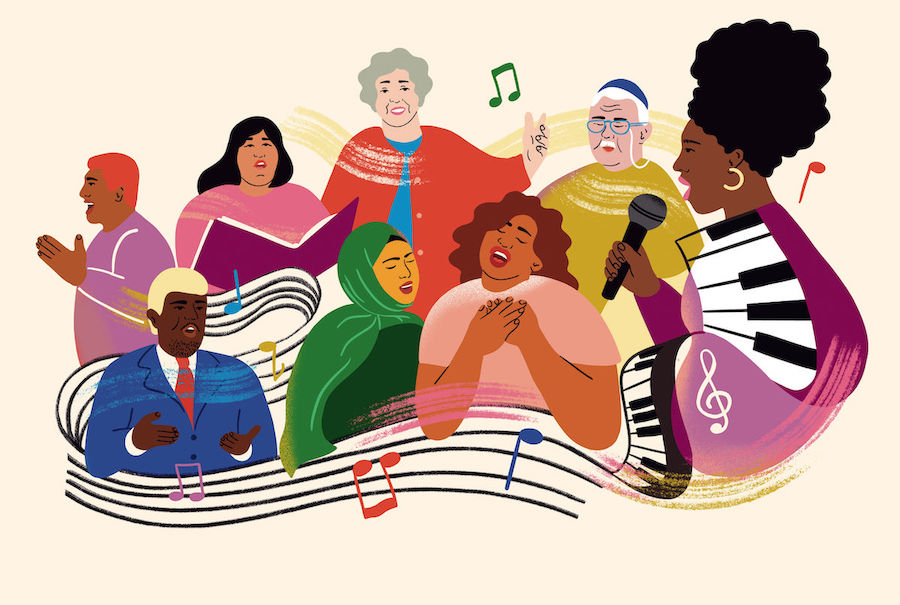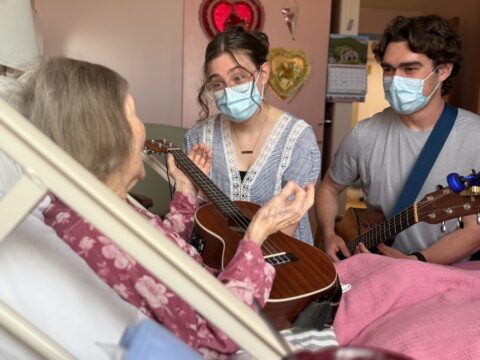Even though it’s been decommissioned, the former St. Peter’s Anglican Church in Toronto feels like an overstuffed living room. There are bikes in a corner, filing cabinets stacked against the walls and wood panels decorated with paper fish that kids have made. Tonight, it’s also filled with choristers. We step out of the looming dusk and into the warm chandelier light. One of tonight’s two choir directors greets us with a smile. “Time to go to church,” says Sophia Grigoriadis.
Like most adults, I haven’t sung in a choir since elementary school. I barely remember what that was like. But here I am, two decades later, expectations high, joining the 70-odd people who sing together in City Choir for two hours every week.
I’ve become fascinated with whether singing provides broad social benefits, a question sparked by the viral clip of a Paramore concert in Dublin. The crowd gets swept up into a singalong cover of the Cranberries’ hit Dreams. Thousands of people singing together about hope and loss, the comments gushing with gratitude. “I had tears in my eyes singing along,” one person says on TikTok.
I already know what science has said about the personal benefits of singing with others. There’s rarely a downside. It helps express emotion and foster relationships. It can even fortify your self-esteem if you sing something like a folk song that carries cultural significance for you. Multiple studies over the past decade have shown that the mental health benefits of singing with others are consistent across different groups of people, in crowds both large and small.
But communal singing can also be an agent of social change. “I think of it in terms of personal change, community change and social change,”says Deanna Yerichuk, a music professor at Wilfrid Laurier University in Waterloo, Ont., who studies the role of communal music-making in social movements. For her, it goes like this: if the personal change is a boost in mood, and the community change is conviviality toward the people you’re singing with, then the social change is about marshalling those emotions against injustice.
Historical examples include wartime songs like The Battle Hymn of the Republic, published in 1862 to encourage Americans fighting during the Civil War to abolish enslavement. In the early 20th century, industrial workers took universal folk tunes and added new lyrics about their struggle for rights, creating songs like Solidarity Forever. The civil rights movement popularized We Shall Overcome. When sung in a crowd, all these songs both unite protesters and also spread their message. “Music can go a long way to do that without having to be didactic or combative,” Yerichuk says.
When protest songs are combative, they can bite. Un Violador en Tu Camino (A Rapist Is in Your Path) became an anthem in 2019 for protests against gender-based violence in Chile. The lyrics take aim at both individual acts of misogyny and the system that denies women justice: “The rapist is you, the police, the judges, the state, the president.”
After Mahsa Amini, who opposed the mandated wearing of hijabs in Iran, died in custody in 2022, protesters took up Baraye (For) as a rallying cry. Singer-songwriter Shervin Hajipour pulled his lyrics from tweets Iranian protesters posted describing their goals: “For longing to have an ordinary life … for the rising sun after the long-lasting night.” His song racked up more than 40 million views in two days after he posted it on Instagram. Last year, he won the inaugural Grammy Award for best song for social change.
Of course, I’m not expecting something as grand from a single evening’s rehearsal. But I am hoping for magic. Whenever a singalong has stood out to me as an example of a spontaneous community being formed, it’s been awe-inspiring to behold. I’m thinking about Freddie Mercury conducting a crowd of thousands at Live Aid 1985, or Canadian sensation Choir!Choir!Choir! filling Massey Hall with pop hits. I want a spine-tingling moment when the stranger singing next to me suddenly feels familiar, what French sociologist Émile Durkheim once called “collective effervescence.”
More on Broadview:
- Why everyone should be encouraged to sing
- This choir for Canadian newcomers offers more than singing lessons
- Celebrated composer Eleanor Daley on what inspires her choral work
Compared to the power of those performances, tonight’s rehearsal feels like rote work. Because we are a group of untrained, unauditioned hobbyists, there are several singers who are off-key or off-beat or too shy to sing above a murmur. We repeat tricky passages until some vocal harmony begins to emerge.
It’s not awful, but it’s clearly a work in progress. How are we supposed to create a transcendent moment or a sense of community if we can’t produce a clean, powerful sound? We interact with others all the time in mundane social situations at work, in the line at the supermarket, at parties. Surely the operative difference between those situations and this one, the X-factor that makes singing such a powerful bonding tool, must be the quality of the music we create. Right?
Frustrated, I turn to John Millard, a longtime Toronto musical director who has been with City Choir since it started in 2010. But he says “epiphany moments” have grown rarer over his career. “I’m a craftsman,” he says. “It’s working with the materials you’ve got to get something as good as the materials will offer you.”
It’s a lovely sentiment, but I’m struggling to see the seeds of social change. I get the sense that I’m mistaken about something.
Maybe I’m just being a grinch. The singing does seem to tick two of Yerichuk’s boxes: both mood boosting and shared conviviality. And the attendees do seem to appreciate each other’s company most of all. One man tells me his love of communal singing comes from the Sabbath table songs his Orthodox Jewish family taught him. A newer member tells me that, like me, they really haven’t sung in public since high school.
I resolve to come to next week’s practice as well. Everyone keeps telling me that another director will be conducting then, and the way they talk about him gives me some hope. “Oh, you have to meet Waleed,” they say. “His practices are totally different.” The man who mentioned Sabbath table songs says, “I have to get into a joyous state of mind to really sing it properly.” I don’t know what that means, but I’m intrigued.
***
Using communal music as a tool for social change became more popular in the early 20th century, Yerichuk says. As industrialization and immigration created booming urban cities, wealthy social reformers became concerned about the lack of education, crude manners and sheer economic hardship they saw in the slums around them.
Toward the end of the 19th century, British philanthropists created social service centres in low-income neighbourhoods called “settlement houses.” These organizations operated daycares, clinics and libraries, and financed parks and playgrounds. When the movement spread to the United States, and from there to Canada, settlement house staff began to offer classical music lessons. “They were trying to figure out how to build community and how to support underprivileged people to lead better lives,” Yerichuk says.
But one person’s noble effort is another’s travesty. Yerichuk’s research has found that Toronto’s settlement houses overlooked the folk songs European immigrants brought with them in favour of canonical western art music. They featured minstrel shows and racist plays about Indigenous Peoples. They supported the systemic racism of the day by excluding everyone and everything that didn’t conform to a white, European, Christian concept of what community should look like.
“There’s a kind of shininess around community music where it’s always all good,” Yerichuk says. “I started to wonder, ‘Is everything great all the time?’ There must be room for us to be critically reflective of the work that we’re doing.”
The fallout was that by the 1940s, settlement house music curricula in Toronto remained overwhelmingly European. Chinatown, by contrast, had a notable Cantonese opera scene.
Today, most choirs are becoming attuned to removing Eurocentric biases in their set lists. One reason City Choir employs a rotating list of six musical directors is so choristers learn about different musical traditions. Across the country, more choirs are incorporating Black musical traditions like gospel or contemporary Indigenous compositions.
Evidence is emerging that broadening the song choices can lead to social benefits. In 2019, Yerichuk and a colleague led 350 Waterloo high school students in a series of workshops teaching them Gahu, a song-and-dance routine from the Ewe people of southeastern Ghana and Togo. At the time, there were no Black, African or Caribbean music teachers in the school district. White teachers said the workshops prompted them to think about Eurocentric bias in their curricula.
But community choirs make up just nine percent of the country’s choirs, according to a 2017 survey by Choral Canada. (The majority — nearly two-thirds — are church choirs, and the rest are in schools.) Community choirs just don’t have the capacity to educate broad swathes of the country. Instead, many serve particular communities as a way to help them feel included and respected. Among them: Echo women’s choir in Toronto, the Ismaili Muslim Youth Choir and the many 2SLGBTQ+ choirs that have been a safe space for queer people since the 1970s.

Ren Challacombe, a disabled transgender chorister and music doctoral student at Queen’s University in Kingston, Ont., has started Spectrum Voices, Kingston’s first 2SLGBTQ+ choir. Challacombe researches trans choristers and is exploring how “gender euphoria” can emerge in a choir when trans people feel more secure in their gender identity.
Challacombe has heard of people being stared at for singing in pitches that outwardly conflict with their presented gender, like a man singing with a high “woman’s” voice. But in accepting choirs, Challacombe’s research participants come to appreciate the unique timbre of their voices.
Another participant in hormone therapy had repeated voice cracks while singing in a trans-affirming choir that Challacombe studied. “But in his experience, people in the choir (both cis and trans) accepted those changes and laughed along when it happened. Not out of humiliation, but of a shared understanding that the process of becoming one’s truest self can be messy.”
***
I return to City Choir the next week musing on these stories. So far, my expectation has been that community singing must be unique among other social interactions in some way. I keep looking to the actual singing for that distinction. But what if it’s something to do with the way choristers interact with each other instead?
As the choristers fill in the pews of St. Peter’s, I study their faces and think back to the medley of voices I heard last week. A subtle psychodrama may be playing out among them that’s not obvious from the music alone. Are the quiet singers already feeling apprehensive about performing aloud? Are the loud singers already thinking about gaps in the music where they should tone it down?
My reverie is interrupted by the appearance of the mysterious new choir director. Waleed Abdulhamid turns out to be a slim middle-aged man with an easy laugh and a shock of black hair emerging from the back of his flat cap. A talented multi-instrumentalist who’s been touring Europe, Asia and North America since he was 18, Abdulhamid continues to teach by ear in the sub-Saharan musical traditions he was first trained in.
In 1991, he set down roots in Toronto after dropping out of a fully funded program at Columbia University in New York. He teaches in workshops and classrooms, speaking of African musical traditions with a deep pride; tonight he wears two different coloured pendants shaped like that continent.
Abdulhamid introduces the first piece in his reedy voice: a South African folk song. There’s no notation, just a set of lyrics. He expects us to learn the melody by singing along. “He’s a beautiful singer, but he does it different every time,” the man next to me whispers wryly.
This time, I see how the singers’ discussion of pronunciation and melody is more like a negotiation than a breakdown in the music. Everyone has a shared interest in a grand end result, but the process requires co-operation, sorting out how all the voices fit together.
Abdulhamid’s freestyling direction also encourages expression. He proffers no precise harmony but asks that we improvise. Someone makes an unexpected dynamic jump, and he quickly suggests we all follow along. Altogether, the session feels not just more surprising, but fun.
“In Africa, we don’t really go with chords,” Abdulhamid says. “You sing the third, these guys sing the fourth, these guys sing the fifth — no. Just offer me anything. Close your eyes and do it naturally.”
He calls this environment “the village” because it combines the unpretentious, improvisational style of a casual gathering with a close-knit community’s ability to elevate and lift the spirit through art and belonging.
When people struggle with the lack of a fixed harmony, he insists they try to be freer. “Offer whatever you have to the village,” he implores. “That’s what we do here.”
I’m struck by the word “offer.” It really captures the feeling of generosity in this space. One person describes it as the trust that someone else will compensate for any “bum notes” you squeak out. Another says that whereas previous choir directors have told her that she’s too loud to be a member of a balanced choir, here she can sing as loudly as she wants and everyone welcomes her powerful sound.
“To be able to sound bad and just make music together — to be able to take that risk — might actually be part of the bonding experience,” Yerichuk says afterwards, when I ask for her thoughts. “‘Offering’ is a beautiful way of suggesting that, because we’re always in relationships. …Even if what we’re hearing is the whole, each person is bringing what they have to offer to create that whole.”
The last song for tonight is in Sudanese Darija. Abdulhamid tells us to sing in a spirit of celebration, for life, death, rain, whatever we want. He drums out a rhythm as we sing and fills the space between melodic lines with jubilant vocables, which are trills and shouts that don’t have any meaning. They seem to bound above our harmony to fill the church hall.
Finally, I see what I’ve been missing. The sense of community in this choir doesn’t depend on making a beautiful sound, but when someone else sings with passion, the feeling of togetherness grows stronger. There is an easy trust in the village when you can sing without fear. Fold everyone into that trust, and the village thrums with joy.
After the session, a young man approaches Abdulhamid and asks how to improvise a vocable. He says singing in this choir has helped his social anxiety, but getting so swept up in the moment is daunting. Abdulhamid gently encourages him to try next time. He has a soft confidence that the choir will offer their voices to him if he offers his. “That’s what the village is,” Abdulhamid says. “You include yourself and you’re gonna learn.”
In other words, communal singing isn’t a shortcut to creating social change. It’s a process, requiring time for everyone to trust each other’s contribution to the sound. That trust, in turn, creates social bonds that last after a practice ends.
As I’m jotting down these final thoughts, the church clears out apart from a group of women practising another piece: Where Have All the Flowers Gone?, Pete Seeger’s plaintive anti-war song. I think the women have nailed the harmony, but they aren’t satisfied. They keep practising. As they do so, I think about the protests against the Vietnam War this song spoke to. Those crowds of thousands of young people seem so different from this quiet scene of a handful of musicians going over and over a passage, fine-tuning their pitch and breath. Or maybe not — who’s to say?
CORRECTION: An earlier version of this story incorrectly stated that Darija is a Sudanese-Arabic dialect. In fact, it most commonly refers to Moroccan Arabic. Broadview regrets this error.
***
Tahmeed Shafiq is a journalist and writer in Toronto.
This article first appeared in Broadview’s March 2024 issue with the title “Living Choir.”














